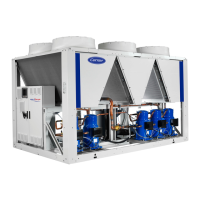67
A133 (Circuit A Low Suction Pressure)
— This alarm indi-
cates that after the compressor has been running for 1 minute
one of the following has occurred: suction pressure is below
34 psig (234 kPa), saturated suction temperature is less than
12 F (–24.4 C) for 8 seconds, the suction pressure falls below
23 psig (158 kPa), or saturated temperature is less than –18 F
(–27.8 C). The Circuit A low suction pressure alert occurs and
the circuit is shut down. The reset function will occur automat-
ically for the first daily occurrence and manually (MBB) for
each reoccurrence.
If this condition is encountered, check the following items:
• Check the unit refrigeration charge, a low charge condi-
tion can cause low suction pressures.
• Check the TXV operation.
• Check the liquid line service valve to be sure that it is
fully open.
• Check the liquid line filter drier for a restriction.
• Check the head pressure control device. For 30MPA
units, check the remote condenser to be sure that it is
operating correctly. If the remote condenser does not
have head pressure control, consider adding it. For
30MPW units, check the condenser water regulating
valve for proper operation. If the unit does not have head
pressure control, consider adding one, or adjusting the
loop temperature.
A140 — Reverse Rotation Detected
Criteria for Trip: The alarm criterion is checked when the first
compressor in a circuit is started. The control writes the value
of the suction pressure 5 seconds before starting the first com-
pressor in the circuit. At the time the compressor is started,
another reading is obtained. A rate of change is calculated
based on the two values and extrapolated to the expected value
5 seconds later. The suction pressure is obtained 5 seconds
after the compressor has been started. If the suction pressure is
not at least 1.25 psig (8.62 kPa) lower than the expected value
or the upper limit for proof of proper rotation, a reverse
rotation alarm is declared.
The example below lists sample suction pressures of a starting
circuit. Figures 46 and 47 show reverse rotation detection for
this example.
Using the rate of change of the suction from the example,
five (5) seconds after t=0, the suction pressure should be 193.8
psig (1336 kPa), if the compressor did not start. Subtracting
the 1.25 psig (8.62 kPa) from extrapolated suction pressure,
192.55 psig (1328 kPa) determines the upper limit that if the
suction pressure is above this level the unit will fault on reverse
rotation. This point is denoted by a black dot in Fig. 46 and 47.
In the example, the suction pressure is lower than the upper
limit, and therefore is allowed to continue operation.
Action To Be Taken: The unit shuts down immediately.
Reset Method: Manual.
Possible Causes: If this condition is encountered, check the
following items:
• Check the wiring of the incoming power for proper phas-
ing. This alarm may be disabled once the reverse rota-
tion check has been verified by setting Reverse Rotation
Enable Configuration
SERV
REV.R=DSBL.
• Check for an inoperative compressor
30
40
50
60
70
80
90
100
110
120
130
140
150
160
170
-30 -20 -10 0 10 20 30 40 50 60 70 80
SCT (F)
SST (F)
a30-5979
LEGEND
SCT —
Saturated Condensing Temperature
SST —
Saturated Suction Temperature
Fig. 45 — Operating Envelope for R410-A Compressor, 30MPW050-071 Units
TIME
SUCTION
PRESSURE
psig (kPa)
SATURATED
SUCTION
TEMPERATURE
°F (°C)
t=–5 (5 seconds before
compressor start)
200.4 (1382) 70 (21.1)
t=0 (compressor start) 197.1 (1359) 69 (20.6)
t=5 (5 seconds after
compressor start)
169.6 (1169) 60 (15.6)

